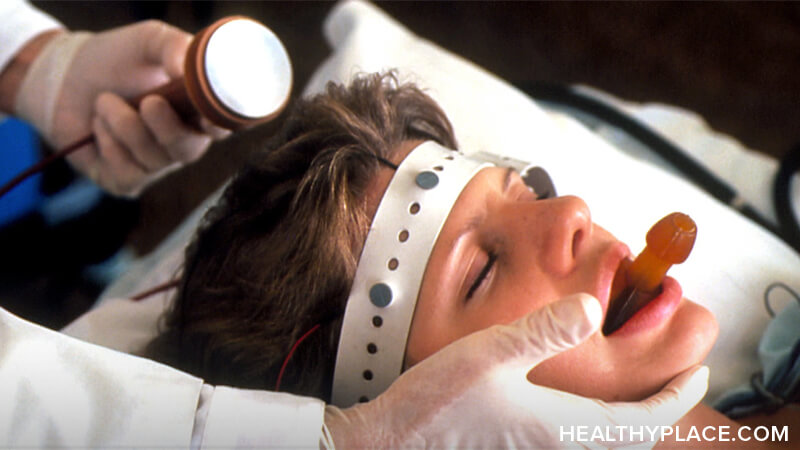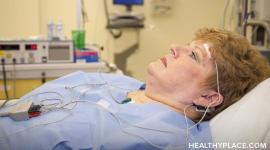What is ECT (Electroconvulsive Therapy) for Depression?

You may be surprised to learn electroconvulsive therapy (ECT) is still being practiced in most, if not all, psychiatric units in general hospitals and mental institutions. ECT is the procedure of stimulating the brain through the use of an electrical current applied directly to the skull.
What is the History of ECT?
The original use of electricity as a cure for "insanity" dates back to the beginning of the 16th century when electric fish were used to treat headaches. Electroconvulsive therapy originates from 1930's research into the effects of camphor-induced seizures in people with schizophrenia. In 1938, two Italian researchers, Ugo Cerletti and Lucio Bini, were the first to use an electric current to induce a seizure in a delusional, hallucinating, schizophrenic man. The man fully recovered after 11 treatments which led to a rapid spread of the use of ECT as a way to induce therapeutic convulsions in the mentally ill. (more about the history of ECT)
Public Perception of ECT
When we think of ECT, some recall the terrifying image of Jack Nicholson in "One Flew Over the Cuckoo's Nest." While this depiction suggests ECT is used to control patients, this is not an accurate portrayal of the present day ECT.
Many years ago when psychiatry was less advanced, ECT was used for a much wider range of mental illnesses and sometimes, unfortunately, it was used to control troublesome patients. Patients who went through ECT might also have suffered broken bones before the advent of modern anesthesia and muscle paralytics.
What is Modern ECT Like?
Today, the American Psychiatric Association has very specific guidelines for the administration of ECT. Electroconvulsive therapy is to be used only to treat severe, debilitating mental disorders and not to control behavior. In most states, written and informed consent is required. The doctor must explain in detail to the patient, and / or family, the reasons why ECT is being considered along with the potential electroconvulsive therapy side effects.
Electroconvulsive therapy is generally used in severely depressed patients for whom psychotherapy and depression medication have proven ineffective. As ECT has much quicker antidepressant effects than medication, it may also be considered when there is an imminent risk of suicide. Electroconvulsive therapy is often performed on an inpatient basis, although maintenance ECT may be performed once a week or so as an outpatient. You can watch these ECT videos for a better perspective on modern-day ECT.
How is ECT Performed?
The patient is required to fast for 8-12 hours prior to a treatment of ECT. Involved in the administration of ECT are usually a psychiatrist, anesthesiologist and other supportive medical personnel. The patient is anesthetized with an intravenous injection and then injected with a drug that causes paralysis, to prevent the jerking motions of a seizure. The heart rate and other vital signs are monitored throughout the ECT treatment. (details on how shock treatment for depression works)
Bilateral ECT vs. Unilateral ECT
In bilateral ECT, electrodes are placed above each temple. For unilateral ECT, one electrode is placed above the temple of one side of the brain and the other in the middle of the forehead. An electrical current is then passed through the brain, inducing a grand mal seizure. Evidence of the seizure may show in twitching toes, an increased heart rate, clenched fists or a chest heave. Because current passes through more of the brain during bilateral ECT, it is more likely to cause cognitive side effects such as short-term memory loss than unilateral ECT.
Clinically effective ECT seizures generally last from about 30 seconds to just over a minute. The patient's body does not convulse and the patient feels no pain. During the ECT therapy seizure, there are a series of changes in brain waves on an electroencephalogram (EEG) and when the EEG levels off, this is an indication that the seizure is over. As the patient wakes, they may experience electroconvulsive therapy side effects including:
- Headache
- Nausea
- Temporary confusion
- Muscle stiffness and pain
Safety and Efficacy of Electroconvulsive Therapy
Memory impact is one of the possible side effects of ECT, but opinions vary as to its severity. Many patients report loss of memory for events that occurred in the days, weeks or months surrounding the ECT. Many of these memories return, although not always. Some patients have also reported their short-term memory continues to be affected by ECT for months, although some say this may be the type of amnesia that is sometimes associated with severe depression. (read: ECT for Depression: Is ECT Treatment Safe)
In the first few decades of ECT's use, death occurred in 1 in 1,000 patients. Current studies report a very low mortality rate of 2.9 deaths per 10,000 patients or, in another study, 4.5 deaths per 100,000 ECT treatments. Most of this risk is due to the anesthetic and is no greater than the use of anesthetic for any minor surgical procedure.
Electroconvulsive therapy has been proven an effective treatment of severe depression. Surprisingly, experts are still uncertain as to how ECT works. It is thought ECT acts by temporarily altering some of the brain's electrochemical processes and helping to create new neurons.
APA Reference
Tracy, N.
(2022, January 4). What is ECT (Electroconvulsive Therapy) for Depression?, HealthyPlace. Retrieved
on 2026, January 11 from https://www.healthyplace.com/depression/ect/what-is-ect-electroconvulsive-therapy-for-depression


